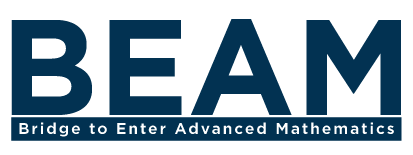In the newsletter, we shared problem 64 from this year’s 100 Problem Challenge:
Remember how squaring works: a number with a 2 exponent should be multiplied by itself. For example, 52 = 5×5 = 25 or 102 = 10×10 = 100.
If
12 + 22 + 32 + 42 + ⋯ + 242 + 252 = 5525 (First Equation)
How can you figure out the following two sums without adding up all the terms?
2 2 + 4 2 + 6 2 + 8 2 + ⋯ + 48 2 + 50 2 = ??? (Second Equation)
3 2 + 6 2 + 9 2 + 12 2 + ⋯ + 72 2 + 75 2 = ??? (Third Equation)
Before we dive into solving these two equations, we hope you’ll take some time to work on the answers and uncover a pattern…
Enough delays, here is the solution!
Let's start off first with the solution, and then with some discussion of why we use this problem at BEAM.
As a BEAM student, I might first want to make sure that I know the meaning of the ellipses in each equation; it means that the pattern repeats in the same way all the way through to the last listed elements. For example, in the first equation, I continue after 42 with 52 + 62 + 72 and so on (This is always the first step of a problem: make sure you understand it!).
These problems are pretty tricky if they're new to you, but once you see it, the solution is fairly straightforward. If I want to solve this problem without adding up all the terms (or computing some of these larger squares!), I should look for a relationship between each statement. The second equation seems to have the sum of square multiples of 2, and the third equation has sums of square multiples of three. Does this mean I can just multiply each equation by 2 and 3 respectively? How can I be sure?
A bit of care shows you that right away. 42 isn't twice as big as 22; it's four times as big (16 vs 4). Similarly, 62 isn't three times as big as 22 , but nine times as big (36 vs 4). If the pattern holds true for each element in the second sum, then each element there will be four times larger; in the third sum, each element would be nine times larger. That pattern does indeed hold true, so the answers are 5525⋅4 = 22,100 and 5525⋅9 = 49,725.
12 + 22 + 32 + 42 yields 1 + 4 + 9 + 16
22 + 42 + 62 + 82 yields 4 + 16 + 36 + 64
32 + 62 + 92 + 122 yields 9 + 36 + 81 + 144
Our hope is that a BEAM student would at this point realize that this isn't just about these two sums; 42 + 82 + 122 + 162 + … + 1002 will be 16 times as large, and so on and so forth. Proving this is not too difficult once you think about it the right way. For example, (2n)2 = (2n)(2n) = (2⋅2)(n⋅n)=4n2 . In general, if you make the number being squared x times bigger, you get (x⋅n)2 = (x⋅n)(x⋅n) = (x⋅x)(n⋅n) = x2n2. Rather than multiplying the result by x, you multiply by x2.
So, why do we like this problem for BEAM students?
There are lots of things that make it compelling. For one thing, the sense of misdirection—where it's not two times larger, but four times larger—makes it compelling. It also helps build skills at both abstraction and generalization. Students learn to work with the ellipses and they're also quickly pressed to generalize from doubling each squared term to other possibilities. For students who haven’t worked with algebra, expressing that is a useful challenge.
Finally, it naturally motivates the relatively simple proof for why the pattern holds; students feel a genuine need for the proof when they see it, because the result was surprising. Motivating proof can be difficult; this problem, with its relatively simple justification, can drive that motivation.
Our 100 Problem Challenge has a mix of problems. You’ve seen more challenging problems in past newsletters, but the mix is important to give entry points to all students and drive growth in new ideas.
